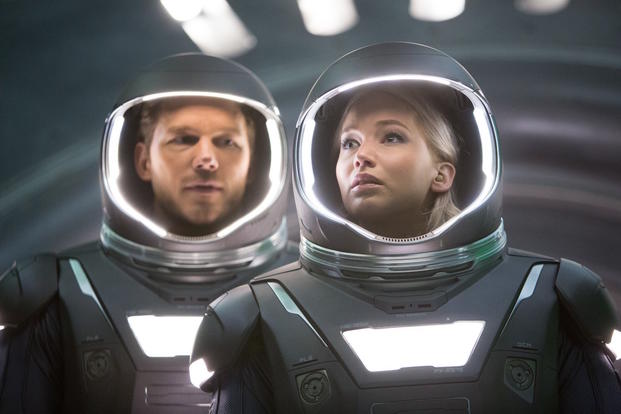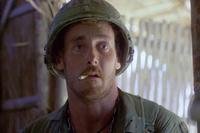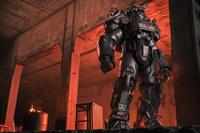Passengers is exactly the kind of movie that all the complainers say they want to see: a big-budget, star-driven movie that's based on a 100% original idea. Jennifer Lawrence and Chris Pratt star in a film that stubbornly refuses to fit into a specific genre: it's part action-thriller, part romantic comedy, part sci-fi meditation on man's place in the universe.
Jim Preston (Pratt) and Aurora Lane (Lawrence) are passengers on the Starship Avalon, taking a 120-year, suspended-animation journey to start a new life on colony planet Homestead II. Both wake up 90 years early and they're stuck in space with only the android bartender Arthur (Michael Sheen) for company. There's a problem with the ship and they're forced to come up with a way to save the other passengers with the aid of a crew member (Lawrence Fishburne) who wakes up in the final act.
%embed1%
There's a lot going on in this movie that's not revealed in the trailers. If you want to be surprised, go soon before the secrets get out. No matter what you think about the characters' motivations and choices, Passengers will surely inspire some spirited discussions after the movie's over.
Passengers was directed by Morten Tyldum (The Imitation Game) with a screenplay by Jon Spaihts, who also wrote the Alien prequel Prometheus and worked on the scripts for Doctor Strange and the upcoming Tom Cruise film The Mummy. Spaihts recently talked about the real science behind the movie at an event in Los Angeles.

On whether a 120-year space journey would look like the one seen in the movie.
Traveling at a fractional light for 120 years, you can't actually get very far. There's really just a basket of stars that they might be going to. We take a little bit of liberties in terms of how interesting things get outside the windows. There has to be some sort of launch or getting them started because it can't be a fractional G. Getting them half the speed of light and down, there's not enough time. But so I had them slingshot past Arcturus, I had a general notion of where they might have found a habitable planet, maybe stretching a little bit how far they might have gone.
On how hard it is to make a movie like this one.
The real challenge of getting the movie made, several-fold maybe, is that it's several kinds of story at once. Hollywood is happiest when you can tell them exactly what they're getting and show them three things like it that made a lot of money. And there isn't anything quite like this. It's a bit of an existential comedy and it's a bit of a passionate love story and it's a bit of a survival thriller. It was a very small cast and a very big frame. So in many ways it felt adventuresome. It's an expensive movie to make and kind of a strange movie to make. So it just took a leap of faith. What really clinched the deal for us was having two such extraordinary stars embrace and endorse it. When they said we want to make this, everybody said, "Well, we do too," and everybody jumped aboard. We really owe the great leap of it to Chris and Jen, who made the movie feasible in the eyes of Hollywood.

On how realistic the film's premise might be and how the spaceship might work.
We're seeing the movement of private companies into the exploration of space and so I postulated a company called the Homestead Company that would find and groom and then ultimately populate exoplanets as colonies. And so that imaging a company that does precisely this work at a more advanced level, that locates planets in a habitable range, around a star, with the right chemical composition, and protective Van Allen belt, and then pioneers them.
Ideally, you want a planet like Homestead 2, which has a chemical composition extremely similar to earth but not a biosphere yet. It's simply a place where the magic didn’t happen or barely happened. You seed that planet with microbiota from earth and with earth life.
So the reason you see pictures of Homestead 2 and their marketing in the film and it looks a lot like earth, it's because it is essentially a parallel earth that is a fertile but ungerminated earth-like world that has been seeded with earth life.
The ship itself exists within the realm of the imaginably possible, meaning that there's no warp drive, hyperspace, no artificial gravity. It runs on fusion and is propelled by a constant trust ion drive. The ship probably gets up to high speed with the aid of some booster or launcher that lobs it out to get it moving, but then after that it's a fractional G constant thrust ion drive. It has a kind of meteor screen at the front, which is probably electromagnetic, but I imagine it has some aspects of a Bussard ramjet, meaning it is actually collecting space gas as it flies for fuel and for ion propellant. It's actually harvesting mass and it solved the propellant problem by harvesting the trace quantities of space dust and gas that exist everywhere.




